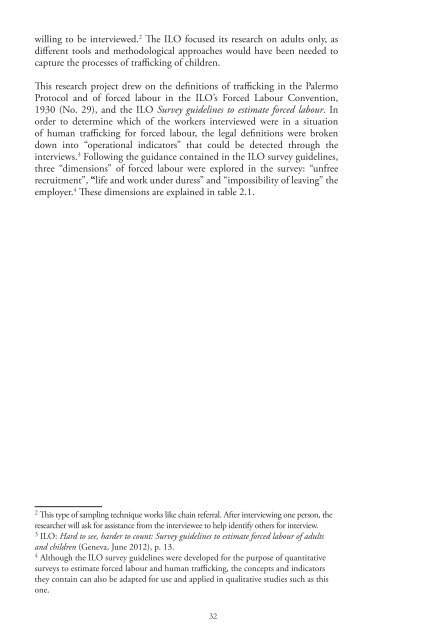Tricked and Trapped: Human Trafficking in the Middle East, ‎pdf 4.1 MB
Tricked and Trapped: Human Trafficking in the Middle East, ‎pdf 4.1 MB
Tricked and Trapped: Human Trafficking in the Middle East, ‎pdf 4.1 MB
Create successful ePaper yourself
Turn your PDF publications into a flip-book with our unique Google optimized e-Paper software.
will<strong>in</strong>g to be <strong>in</strong>terviewed. 2 The ILO focused its research on adults only, as<br />
different tools <strong>and</strong> methodological approaches would have been needed to<br />
capture <strong>the</strong> processes of traffick<strong>in</strong>g of children.<br />
This research project drew on <strong>the</strong> def<strong>in</strong>itions of traffick<strong>in</strong>g <strong>in</strong> <strong>the</strong> Palermo<br />
Protocol <strong>and</strong> of forced labour <strong>in</strong> <strong>the</strong> ILO’s Forced Labour Convention,<br />
1930 (No. 29), <strong>and</strong> <strong>the</strong> ILO Survey guidel<strong>in</strong>es to estimate forced labour. In<br />
order to determ<strong>in</strong>e which of <strong>the</strong> workers <strong>in</strong>terviewed were <strong>in</strong> a situation<br />
of human traffick<strong>in</strong>g for forced labour, <strong>the</strong> legal def<strong>in</strong>itions were broken<br />
down <strong>in</strong>to “operational <strong>in</strong>dicators” that could be detected through <strong>the</strong><br />
<strong>in</strong>terviews. 3 Follow<strong>in</strong>g <strong>the</strong> guidance conta<strong>in</strong>ed <strong>in</strong> <strong>the</strong> ILO survey guidel<strong>in</strong>es,<br />
three “dimensions” of forced labour were explored <strong>in</strong> <strong>the</strong> survey: “unfree<br />
recruitment”, “life <strong>and</strong> work under duress” <strong>and</strong> “impossibility of leav<strong>in</strong>g” <strong>the</strong><br />
employer. 4 These dimensions are expla<strong>in</strong>ed <strong>in</strong> table 2.1.<br />
2<br />
This type of sampl<strong>in</strong>g technique works like cha<strong>in</strong> referral. After <strong>in</strong>terview<strong>in</strong>g one person, <strong>the</strong><br />
researcher will ask for assistance from <strong>the</strong> <strong>in</strong>terviewee to help identify o<strong>the</strong>rs for <strong>in</strong>terview.<br />
3<br />
ILO: Hard to see, harder to count: Survey guidel<strong>in</strong>es to estimate forced labour of adults<br />
<strong>and</strong> children (Geneva, June 2012), p. 13.<br />
4<br />
Although <strong>the</strong> ILO survey guidel<strong>in</strong>es were developed for <strong>the</strong> purpose of quantitative<br />
surveys to estimate forced labour <strong>and</strong> human traffick<strong>in</strong>g, <strong>the</strong> concepts <strong>and</strong> <strong>in</strong>dicators<br />
<strong>the</strong>y conta<strong>in</strong> can also be adapted for use <strong>and</strong> applied <strong>in</strong> qualitative studies such as this<br />
one.<br />
32
















